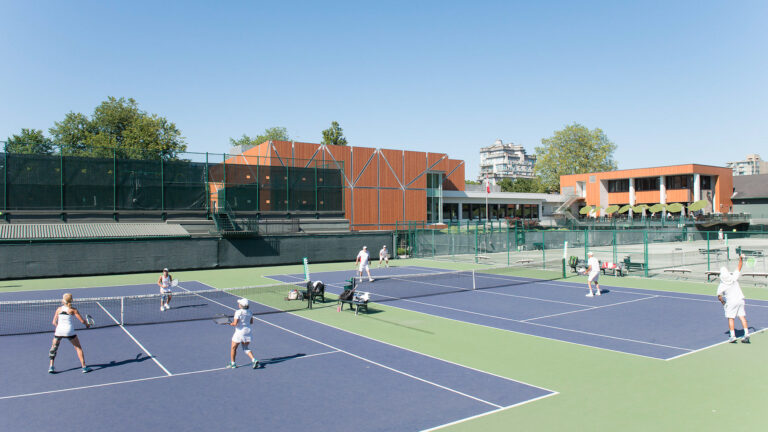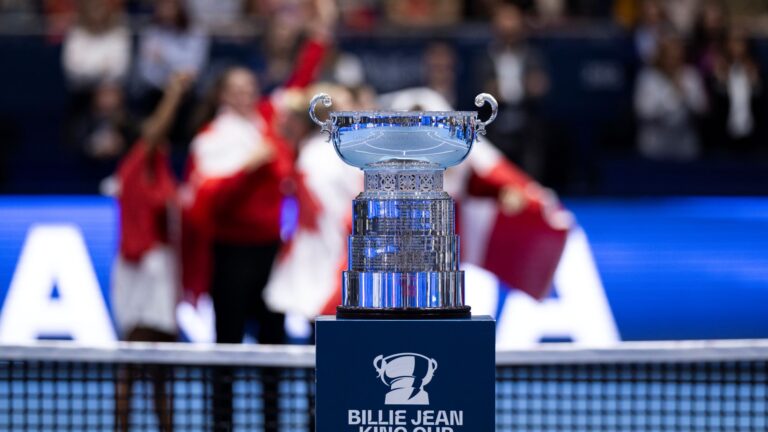
Winning a Grand Slam tournament doesn’t take place in a vacuum-sealed environment – though things have changed at Wimbledon and the Australian Open with their retractable roof stadiums. A lot of variables are not under control.
Novak Djokovic is pursuing a career-crowning victory at the 2015 French Open, a victory that would give him a first Roland Garros title and allow him to join seven others – Budge, Perry, Emerson, Laver, Agassi, Federer and Nadal – who have won all four Grand Slam titles in their tennis lifetimes.

In the past at the French Open, he has been somewhat star-crossed. He has always had to overcome clay-court titan Rafael Nadal, and particular situations such as the 2012 final when rain interrupted the fourth set when he was on a roll, an unfortunate touch of the net at a critical point in the fifth set of the 2013 semifinal and unusually hot, humid conditions for final’s day a year ago.
On Friday night, Djokovic goes to bed leading Andy Murray 6-3, 6-3, 5-7, 3-3 after darkness and inclement approaching weather forced postponement until 1 p.m. (7 a.m. EDT in Canada) on Saturday. Djokovic, clearly the best player in the world over the past year, appeared to get a little tight and press in the third set as he tried to wrap up the match before approaching rain and darkness forced a stoppage.
He may be haunted by 2012 when Murray defeated him in five sets in the US Open final after Murray got a day’s rest before the final when he completed his semifinal with Tomas Berdych on Saturday while threatening thunderstorms forced Djokovic to play three sets on Sunday to complete his semifinal against David Ferrer.

Now Djokovic will need to play three days in a row in a similar situation as Stan Wawrinka is already in the final after beating Jo-Wilfried Tsonga 6-3, 6-7(1), 7-6(3), 6-4 in a match that lacked consistently inspired play but in which the 30-year-old Swiss, Australian Open champion in 2014, was unquestionably the deserving winner.
There are a number of historically significant elements that suggest Djokovic deserves to win Roland Garros this year. Of all active players who have not won the French Open (i.e. everyone but Nadal and Roger Federer), he has by far the best record – two runner-up finishes and five semi-finals. Only David Ferrer (a final and a semi-final), Murray (three semi-finals), Tsonga (two semi-finals) as well as Tomas Berdych, Juan Martin del Potro, Ernests Gulbis, Jurgen Melzer, Gael Monfils and Wawrinka (one semi-final) have even reached the final four.
There’s also a comparison with Federer, who ended four years of Nadal’s reign at Roland Garros by winning in 2009 after previously being in three finals and one semifinal. Federer won his title at 27, just two months before he turned 28. If Djokovic wins this year, it would be just 16 days after turning 28 and he would be ending a streak of five-in-a-row Nadal conquests.
Since losing to Tsonga at Rogers Cup last August, to Kei Nishikori at the US Open and to Roger Federer in Shanghai in October, Djokovic has won all seven major tournaments – six Masters-level events and the Australian Open – he has played.
His only losses in 2015 so far came while he was ill in Doha (Ivo Karlovic) in early January, and Dubai (Federer) in February when he may still have been reveling in his fifth Australian Open victory a few weeks earlier.
Djokovic probably had the best year in modern times in 2011 when he won Wimbledon as well as the Australian and US Opens and overtook two modern-era giants – 6-0 vs. Nadal and 4-1 vs. Federer – in an amazing season.

If he is to accomplish his No. 1 goal of winning Roland Garros, it will come with the obstacle of getting by Murray on Saturday and then beating Wawrinka – he leads the head-to-head 17-3 but the Swiss has played him tough in best-of-five matches at Grand Slams.
If that happens, there will inevitably be speculation of a calendar Grand Slam with Wimbledon and the US Open looming. But, just as has been the case with Djokovic and his quest for a Roland Garros title, so many imponderables can arise making the Grand Slam the sport’s ultimate challenge by far. It’s the reason it hasn’t happened since Rod Laver in 1968 and why no one has even gotten within one Slam of accomplishing it in the Open Era.
Serena: Lazarus again?

Saturday’s women’s final seems to be all about how healthy Serena Williams will be come game-time.
She suffered seriously with a flu-like condition in a semifinal 4-6, 6-3, 6-1 victory over Timea Bacsinszky on Thursday and missed a scheduled media conference and a practice session on Friday.
It’s anyone’s guess but few would bet against her being able to play and win on Saturday. Williams is at the top of the list of greatest ever competitors in women’s tennis along with champions like Chris Evert and Monica Seles who had off-the-charts strong wills and exceptional competitive clarity in the crises of tennis matches.
In four of her six rounds at this year’s Roland Garros – and always against inferior opposition because she is indisputably the best – Williams has come back from a set down to win.
And having the flu isn’t like having a busted shoulder or wonky knee – the body parts still function and sometimes an illness or fever can actually help a player focus better.
As well, there’s that 8-0 record against her final opponent Lucie Safarova, with Safarova having only won three sets. But one was in a 6-1, 1-6, 6-2 loss in Beijing last fall.
Safarova, 28 and about to be ranked in the Top 10 for the first time in her career, has always been a freewheeling, power hitter and a good athlete, but maintaining her nerve in big matches has always been her fatal flaw.
She at least partially dispelled that notion with a poised 7-6(3), 6-4 victory over No. 2 seed Maria Sharapova in the same Philippe Chatrier stadium where she will face Williams at 3 p.m. (9 a.m. EDT in Canada on TSN and RDS) in the final.
The left-handed Safarova has a big forehand that she can hit with power, but which she can also move around, finding devilish angles. Already this year in Paris, she has beaten big-hitters Sabine Lisicki, Sharapova, Garbine Muguruza, in an high-quality quarter-final encounter, and Ana Ivanovic 7-5, 7-5 in Thursday’s semifinals.
That should help her be better prepared for Williams’ concussive ground strokes that can end rallies before they even begin.
For Williams, the stakes are obvious. She has struggled more at Roland Garros than at any of the Grand Slams – winning there just twice compared to at least five times each at Wimbledon and the Australian and US Opens.
More importantly, it would get her to the symbolically significant total of 20 Grand Slam victories – one more than 1920-30s era star Helen Wills of the U.S. and two more than more recent grand dames Evert and Martina Navratilova.
She would remain behind Steffi Graf’s 22, although there’s an asterisk there. The main rival of the German’s prime years, Monica Seles, was stabbed in 1993 at a time when the then-Yugoslavian had won seven of her eight previous Grand Slam events but was ultimately never able to return as the peerless player she had been.
As well, she would trail leader Margaret Court of Australia and her 24 titles – with the asterisk in her case being that 11 of those were won in Australia with relatively weak international fields between 1960 and 1973.
The nice round figure of 20 Grand Slam triumphs might put an end to serious discussion about whether there has ever been a greater, more dominant player in the women’s game than Williams.

A Safarova victory would be widely welcomed among her peers because the Czech is popular and well-liked by her fellow travelers of the WTA tour. The subject came up in her media conference on Thursday, with one reporter wanting to know if a ‘good guy’ could win the title. Safarova responded, “I hope so. (Smiling.) I think sport should be about fair play. I think, yeah, people should be nice to each other. Doesn’t matter if it’s in sports or in general.
“So that’s what I’m trying to do. I have a few good friends on tour. It’s not easy when you play them, but that’s the life.”
Winning the title would allow her to go one better (he was a Wimbledon runner-up in 2010) than her longtime former boyfriend, compatriot Tomas Berdych.
It would also probably be a handsome payday for her coach, Rob Steckley from Toronto. He has worked hard to help her believe in herself and if he is one of the coaches paid on a percentage of prize money basis – say in the high range at 10 per cent – he could receive as much as about $280,000 (Can) if she wins Saturday’s final and the women’s doubles final on Sunday with Bethanie Mattek-Sands. Worst case scenario, if she loses both, the former world No. 464 and one-time Davis Cup player for Canada could have a take of about $140,000 (Can).
Of course the main part of that compensation (more than 85%) would be for the singles. Beating Serena Williams, no matter the state of her fitness, will be a mammoth mountain to climb. Maybe Safarova’s obstacle is that she will be too willing to smile if she loses while the steely, driven Williams wants absolutely nothing to do with anything but lifting the Coupe Suzanne Lenglen late Saturday afternoon in Paris.
Paris… Paris… Paris…
![P1040140[1]](http://tcarchive2016.wpengine.com/wp-content/uploads/2015/06/P10401401-1024x673.jpg)
As in many big cities, these birds are very much part of the landscape. This one was comfortably perched atop the grandstand beside Court 6 when Vasek Pospisil practiced there with Jarkko Nieminen on the day before Roland Garros began on May 24.
NOTE: Back with our regular Tebbutt Tuesday on June 9.


